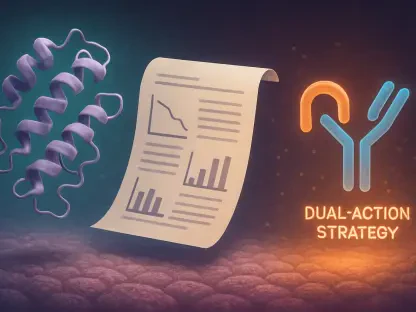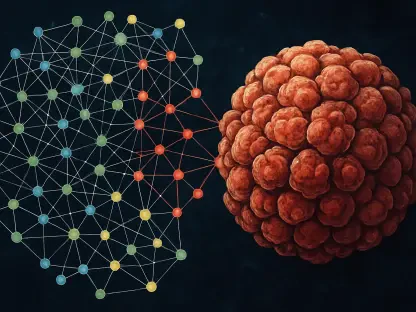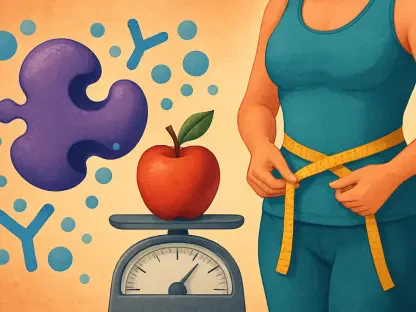Engineered virus-like particles (eVLPs) are revolutionizing the field of gene delivery and editing. These particles are designed to safely and effectively deliver macromolecules, such as mRNAs, proteins, or ribonucleoproteins (RNPs), into cells. While Adeno-associated virus (AAV) vectors have been useful in delivering gene-editing agents, they carry certain limitations that necessitate alternative methods. eVLPs have emerged as efficient delivery vectors that provide advantages such as tissue tropism, reduced off-target editing, transient cargo expression, and increased safety compared to traditional viral vectors.
The recent study discussed in the article, published in Nature Biotechnology, unveils a breakthrough directed evolution system that enhances the capabilities of these engineered particles. This system allows researchers to isolate variants of eVLPs with desirable traits, thus optimizing them for their intended therapeutic roles. By employing a laboratory-directed evolution approach, researchers aim to improve the eVLPs’ production and transduction efficiencies, which are crucial for their effective application in gene editing and therapy.
Introduction of Barcoded Single-Guide RNAs (sgRNAs)
Barcoded sgRNAs for Tracking and Selection
A significant aspect of the study was the introduction of barcoded single-guide RNAs (sgRNAs). These barcodes enable tracking and selection of eVLP variants with specific properties within the laboratory evolution process. By inserting a 15-base pair barcode sequence into the sgRNA scaffold, the researchers demonstrated compatibility with functional eVLP production. This innovative approach allows for precise monitoring of the evolution process, ensuring that only the most effective variants are selected for further development. Through this method, researchers can identify the best-performing eVLPs in a high-throughput manner, thus accelerating the optimization process.
Tracking and selecting optimal eVLP variants is an essential step in improving the efficiency of gene delivery systems. The barcoded sgRNAs enhance the ability to pinpoint specific mutations that contribute to desirable traits, such as increased production and transduction efficiencies. By employing this advanced technique, scientists can systematically evaluate a wide range of eVLP variants and streamline the evolution process. This precision in selection reduces the time and resources needed to develop more effective and targeted gene therapy vectors, ultimately leading to better therapeutic outcomes for patients.
Compatibility with Functional eVLP Production
Validation experiments involved using fourth-generation base-editor (v4 BE)-eVLPs containing adenine base editing (ABE) RNP cargo to ensure that barcoded sgRNAs do not impair eVLP functionality. The standard v4 BE-eVLPs were produced by co-transfecting four plasmids into producer cells, encoding the necessary components for eVLP formation and function. The results showed that introducing barcoded sgRNAs did not impair the functionality of the eVLPs, indicating their effectiveness in tracking different eVLP variants. This compatibility is crucial for the success of the directed evolution system, providing confidence that the tracking mechanism does not interfere with the eVLPs’ intended purpose.
The ability to use barcoded sgRNAs without compromising eVLP function represents a significant advancement in gene delivery research. This compatibility allows researchers to combine precise tracking with functional validation, ensuring that only the most effective eVLP variants are selected for further development. The results of these validation experiments highlight the robustness of the directed evolution system and its potential to improve gene therapy vectors. By integrating barcoded sgRNAs into eVLP production, scientists can achieve a higher degree of control and accuracy in the evolution process, leading to more efficient and targeted gene delivery solutions.
Directed Evolution of eVLP Capsids
Creation of a Capsid Mutant Library
The study applied the barcoded system to create a library of capsid mutants with single-residue mutations in the MMLV Gag protein capsid and nucleocapsid domains. Producer HEK293T cells were used to build and amplify this barcoded eVLP capsid library, creating a diverse population of capsid variants. This extensive library serves as the foundation for selecting variants with improved production and transduction capabilities, a critical step in enhancing eVLP efficiency. By generating a wide range of capsid mutations, researchers can systematically evaluate the effects of each mutation on eVLP performance, ultimately identifying the most beneficial variants for gene therapy applications.
The creation of a comprehensive capsid mutant library is a pivotal step in the directed evolution process. It allows researchers to explore a vast landscape of potential mutations, each of which could improve eVLP production and transduction efficiencies. By leveraging the diversity of the capsid library, scientists can identify specific mutations that confer advantageous properties to eVLPs, such as increased stability, higher production yields, and enhanced transduction efficiency. This systematic approach ensures that the most promising variants are selected and further refined, ultimately leading to more effective gene delivery vectors.
Selection and Enrichment Analysis
The barcoded capsid library underwent two selection processes to identify variants with improved production and transduction capabilities. After the initial production process, the capsid variants were sequenced to identify barcodes associated with enhanced eVLP production. The analysis revealed that 8% of the mutants showed better production efficiency compared to the canonical eVLP capsid. Following transduction into target cells and further sequencing, 0.7% of mutants displayed higher transduction efficiencies. Mutations resulting in improved production or transduction without impairing the other property were prioritized for further development, ensuring that selected variants possess balanced and enhanced performance characteristics.
Selection and enrichment analysis is a crucial component of the directed evolution approach, allowing researchers to pinpoint specific mutations that confer advantageous traits to eVLPs. By systematically evaluating the performance of each variant in the capsid library, the study identified those with superior production and transduction efficiencies. These findings underscore the effectiveness of the directed evolution system in enhancing eVLP capabilities. Prioritizing mutations that improve one aspect without negatively affecting another ensures that the selected eVLP variants exhibit overall enhanced performance, making them more suitable for gene therapy applications.
Development of Fifth-Generation eVLPs (v5 BE-eVLPs)
Introduction of Capsid Mutations
Capsid mutations were introduced into the Gag-ABE constructs, leading to varying degrees of increased potency in gene editing. Five mutations showed the highest potency, but the combination of GagC507V-ABE with GagQ226P-Pro-Pol (termed v5 BE-eVLPs) was particularly noteworthy for its significant enhancement in efficiency. These mutations significantly enhance the efficiency and effectiveness of the eVLPs, making them more potent tools for gene editing applications. By systematically introducing and testing various mutations, researchers can fine-tune the eVLPs to achieve optimal performance in delivering gene-editing agents, thus advancing the field of gene therapy.
The introduction of specific capsid mutations into the Gag-ABE constructs represents a critical step in developing more potent and effective eVLPs. These targeted mutations can enhance various aspects of eVLP performance, such as stability, production yield, and transduction efficiency. The success of the v5 BE-eVLPs highlights the importance of precise genetic modifications in optimizing gene delivery vectors. By systematically evaluating the effects of each mutation, researchers can identify the most effective combinations, ultimately creating highly optimized eVLPs for therapeutic applications.
Enhanced Base Editing Efficiencies
V5 BE-eVLPs demonstrated significantly higher base editing efficiencies and greater potency at lower doses compared to the v4 BE-eVLPs. This improvement is a testament to the success of the directed evolution approach, which fine-tunes eVLPs for optimal performance. The enhanced efficiencies of v5 BE-eVLPs highlight their potential for more effective and targeted gene therapy applications. By achieving higher base editing efficiencies at lower doses, these advanced eVLPs can reduce the risk of off-target effects and minimize potential side effects, making them safer and more reliable options for gene editing therapies.
The enhanced base editing efficiencies of v5 BE-eVLPs underscore the impact of the directed evolution system in advancing gene therapy technologies. By optimizing eVLPs to achieve higher efficiency at lower doses, these advancements can significantly improve the safety and efficacy of gene editing treatments. This development opens new avenues for addressing genetic diseases more effectively, as higher editing efficiencies can lead to better therapeutic outcomes with reduced risks. The success of v5 BE-eVLPs demonstrates the potential of iterative selection and genetic engineering techniques in creating next-generation gene therapy vectors.
Implications for Gene Therapy
Overcoming Limitations of Traditional Viral Vectors
The advancements in eVLP technology denote a promising future for gene editing therapies, where safer, more efficient, and highly targeted delivery systems are essential. By leveraging advanced genetic engineering techniques and directed evolution methodologies, significant improvements can be made in the efficiency and safety of gene delivery systems. These advancements enhance the potential for eVLPs in therapeutic applications, opening new avenues for more effective treatments of genetic diseases. Traditional viral vectors, such as AAVs, come with certain limitations, including immune responses and limited cargo capacity, which eVLPs can potentially overcome through precise engineering.
The promise of eVLP technology lies in its ability to provide more effective and safer alternatives to traditional viral vectors. By addressing the limitations of AAVs and other conventional vectors, eVLPs can offer improved therapeutic options for patients with genetic disorders. The continued development and optimization of eVLPs through directed evolution methodologies ensure that these particles are finely tuned for maximal efficiency and minimal risk. This progress reflects the broader trend in gene therapy research, where advanced genetic engineering approaches are being harnessed to create next-generation therapeutic agents that offer superior performance and safety profiles.
Streamlined Approach to Gene Delivery
A recent study featured in Nature Biotechnology introduces a groundbreaking directed evolution system that significantly enhances the functionality of these engineered particles. This system enables researchers to identify variants of eVLPs with favorable attributes, optimizing them for therapeutic applications. By utilizing a laboratory-directed evolution strategy, scientists aim to boost the production and transduction efficiencies of eVLPs, which are vital for their effective use in gene editing and therapy.









